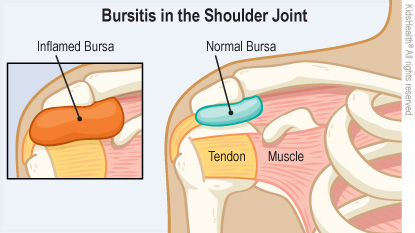Bursitis: How to Care for Your Child
A bursa is a fluid sac located near a joint or tendon. It cushions the joint when the joint moves or feels pressure. Bursitis is irritation, tenderness or swelling of the bursa. Bursitis can happen for different reasons, and it can come on slowly or suddenly. Most cases of bursitis get better with rest, medicine and basic home care. Sometimes physical therapy can be helpful.


-
Your child should avoid activities that cause pain.
-
For pain and swelling:
-
Put a cold pack on the area for 15–20 minutes every 3–4 hours. Place a towel or cloth between the cold pack and the skin.
-
Give an anti-inflammatory medicine, like ibuprofen (such as Advil®, Motrin® or a store brand) or naproxen (such as Aleve® or a store brand), if recommended by your health care provider.
-
Raise the area above heart level by resting it on a pillow.
-
When the swelling goes down, put a heating pad or hot pack on the area for up to 20 minutes at a time to help with pain. Place a towel between the skin and the heating pad.
-
If your health care provider prescribed an antibiotic, give it as directed.
-
Follow the health care provider's instructions about whether your child should wear a bandage, brace or protective device.
-
If the health care provider told your child to use crutches, make sure he or she uses them safely and does not use them on stairs unless shown how to do so properly.
-
Follow the health care provider's instructions about when it's OK for your child to return to sports and other activities.
-
Schedule any follow-up appointments as directed.
-
Repetitive movements and pressure on joints can lead to bursitis. To help prevent bursitis from happening again:
-
Your child should warm up before exercise and cool down afterward.
-
Your child should rest if there is pain during exercise.
-
Make sure your child has well-fitting shoes and sports gear.
-
Ask your health care provider if your child should use pads for sitting, kneeling or other activities that put pressure on the joints.

Your child:
-
still has pain after following the care instructions
-
has pain that gets worse
-
wakes at night from the pain
-
has a fever
-
has pain in other areas of the body
-
has other symptoms, like a rash

Your child:

What causes bursitis? Bursitis usually happens from:
Kids with arthritis and some other conditions sometimes get bursitis. Rarely, a bacterial infection of the fluid inside the bursa can cause it.
What if bursitis pain does not improve with home care? If the pain continues, your health care provider may refer your child to a physical therapist or an orthopedic doctor (bone specialist).